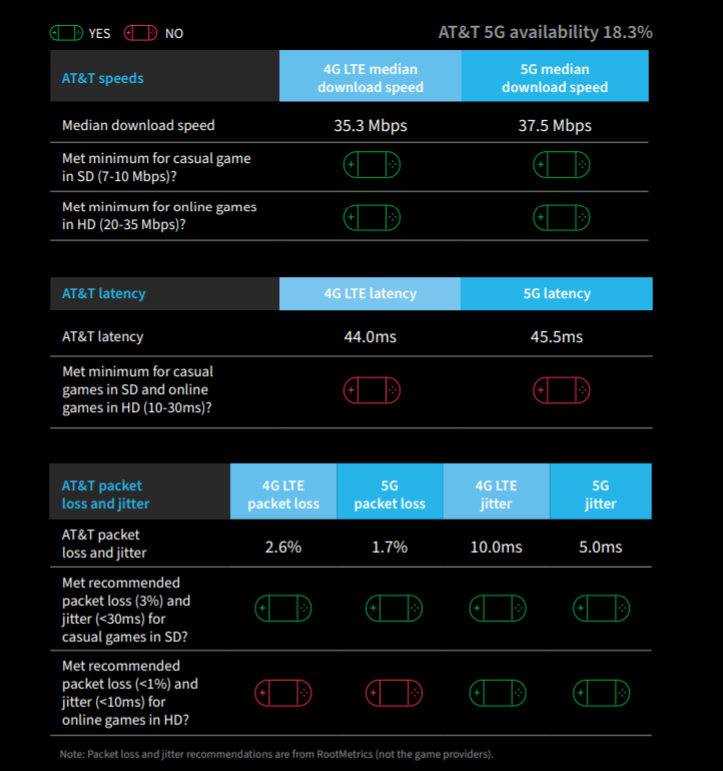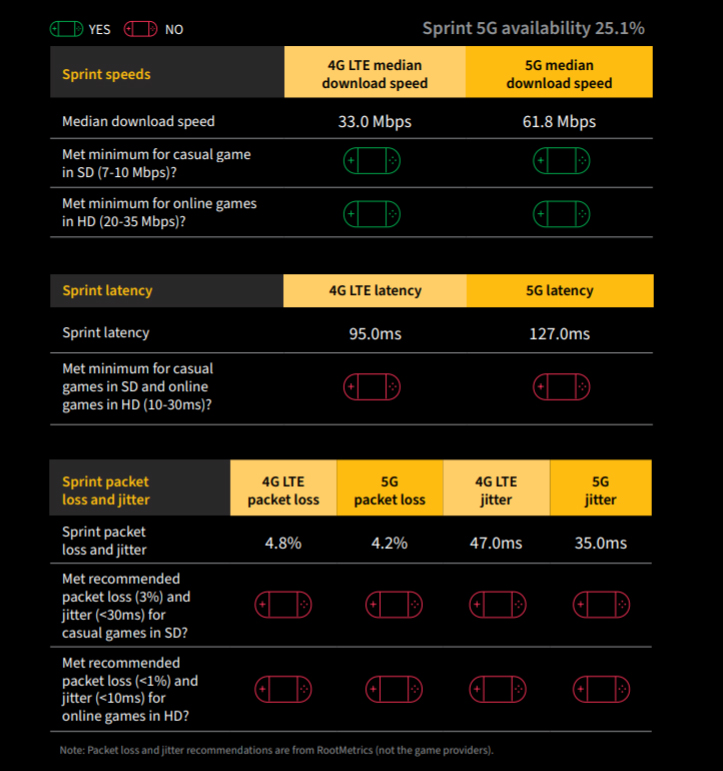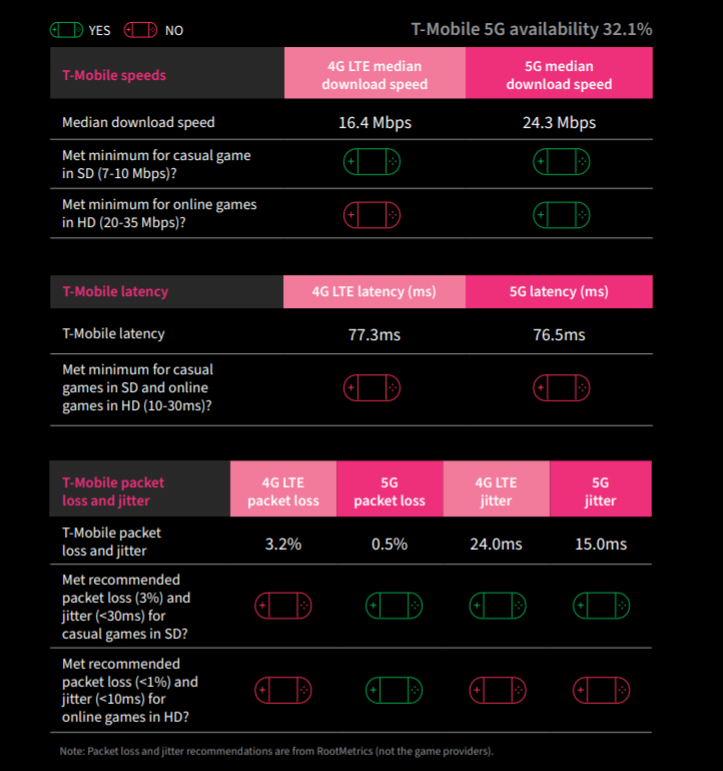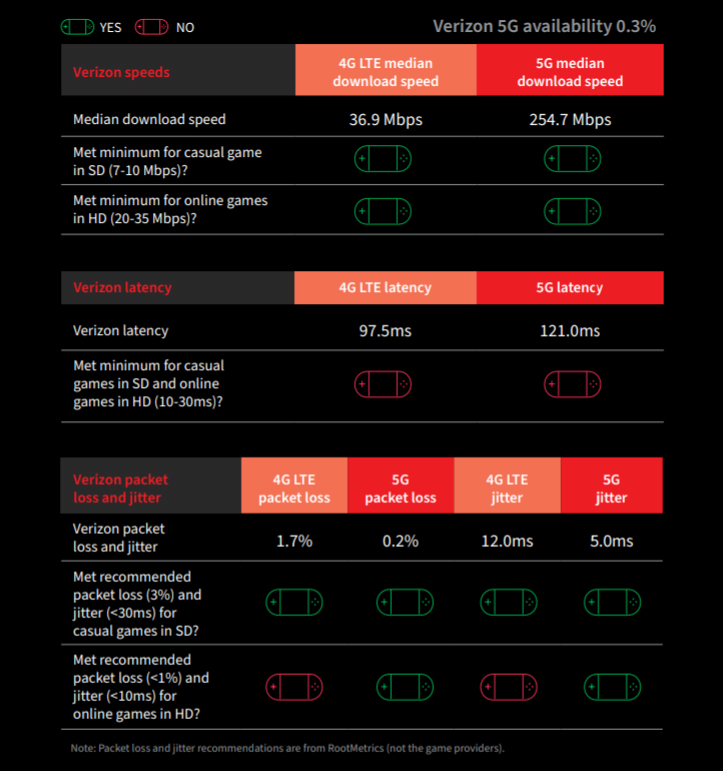Cloud gaming: 4G LTE and 5G networks compared
Discover the the real-world cloud gaming experience in Los Angeles on 4G LTE and 5G with RootMetrics.

According to gaming analytics firm Newzoo, the global cloud gaming market will hit 124.7 million users by 2022, and research firm Niko Partners expects the number of cloud gamers in Asia alone to rise from three million to 60 million by 2023.
And RootMetrics, the independent mobile network research company, has decided to dedicate its latest report to the state of cloud gaming, specifically in LA, where it has tested the cloud gaming performance of the top four MNOs in the United States (AT&T, Sprint, T-Mobile and Verizon).
Titled ‘Mobile cloud gaming: the real-world cloud gaming experience in Los Angeles’, the latest report from RootMetrics puts cloud gaming through its paces. But what exactly is cloud gaming?
What is cloud gaming?
With cloud gaming, rather than install games on their own PC or device, gamers send commands from a mobile device to platforms like Stadia or xCloud or Steam’s Remote Play, where games are hosted remotely. A cloud server receives and executes those commands and then streams the results back to the gamer. And if your speeds and latency are strong enough, gameplay happens in effectively real-time (which, as any gamer knows, is the holy grail of online gaming).
This is why 5G technology is being touted as the first mobile networking technology to fully support cloud gaming, thanks to its lighting fast transfer speeds, and – of course – the low latency that sets 5G apart from the likes of 3G and 4G.

What they tested
For the report RootMetrics tested ‘casual games’ in SD (720p), looking at optimal resolution for casual, single-player games like Words with Friends or Tetris (where latency is less important). RootMetrics then turned its attention to HD games (1080p), all of which were multiplayer.
“The faster speeds of 5G should allow for more advanced and faster video rendering, which would allow gamers to stream more complicated online games on their smartphones with ease."
RootMetrics report.
According to RootMetrics: “In these games, fast reactions and pinpoint accuracy are required, and every frame can make the difference in the outcome. These multiplayer online games typically require perfect chat functionality, exceptional audio and video quality, real-time inputs, and minimal (or zero) delays or lag during gameplay.”
Get up to speed with 5G, and discover the latest deals, news, and insight!
The promises of 5G include greater capacity, much faster speeds, and lower latency, which could eventually lead to dramatic improvements for cloud gaming on mobile devices, especially when we reach a point where latency below 20-30ms is the norm.
“The faster speeds of 5G should allow for more advanced and faster video rendering, which would allow gamers to stream more complicated online games on their smartphones with ease,” the report says.
And while we haven’t quite reached that point yet, the report points out that it’s important to keep in mind that we’re already seeing encouraging 5G speeds and 5G availability.
“In short, the 5G landscape is changing fast and the carriers are making great progress, but it will take time before gamers can put away their consoles and start entering Esports competitions on smartphones,” says the report.
Below we have showcased the results for each of the major network operators in the US, with a brief overview of how they performed. But to access the full report, featuring 20 pages of insight, visit: http://rootmetrics.com/en-US/content/us-LA-gaming-report-2020
AT&T results

“AT&T’s median download speeds on both 4G LTE and 5G easily surpassed the bare minimum speed requirements set by the cloud gaming platforms. AT&T’s latency, meanwhile, was by far the lowest among all four carriers in LA on both 4G LTE and 5G and was very close to the minimums of the providers. While AT&T’s latency was the lowest among the carriers, it was still slightly higher than the game providers’ 30ms minimum standard on both 4G LTE and 5G. That said, the good news is that in the context of mobile cloud gaming, latency below 50ms is generally low enough to allow for relatively smooth gameplay for both casual games in SD and most multiplayer online games in HD.”
Sprint results

“Sprint’s 4G LTE and 5G median download speeds were fast enough to provide both smooth casual gaming and multiplayer online gaming, and even though the carrier’s latency was above the bare minimum threshold for casual games in standard definition, we expect that gamers should still be able to play most casual games without much hassle—especially games that don’t rely on quick reactions and make minimal use of graphics. That said, the carrier’s latency will likely cause issues for fans of multiplayer online games like Fortnite in HD. Sprint’s 4G LTE latency of 95.0ms was over three times as high as what the platforms consider the minimum needed for any type of cloud gaming, and Sprint’s latency on 5G was actually higher at 127.0ms.”
T-Mobile results

“T-Mobile’s 5G speeds were fast enough for casual and multiplayer online games in both SD and HD, and the carrier’s 5G availability was far more widespread than that of the other carriers, with 32.1% of our tests recorded on 5G. T-Mobile’s 5G helped the carrier improve its median download speed from 16.4 Mbps on 4G LTE to a much stronger 24.3 Mbps on 5G. In fact, T-Mobile’s 5G could make a big difference for gamers: the carrier’s 5G median download speed surpassed the minimum speed requirements for both SD and HD gaming, but T-Mobile’s 4G LTE speed fell short for multiplayer online games in HD. T-Mobile also showed strong packet loss and jitter results on 5G. For instance, on 4G LTE, T-Mobile registered a relatively high packet loss rate of 3.2%, but on 5G, that number dropped to 0.5%, which was bested by only Verizon’s 5G (0.2%). Further, T-Mobile’s jitter improved on 5G, dropping from 24.0ms on 4G LTE to 15.0ms on 5G. In simpler terms, gamers on T-Mobile’s 5G shouldn’t see much impact from packet loss or jitter, especially for casual games in SD.”
Verizon results

“Verizon’s median download speeds far surpassed the minimum requirements for both casual and multiplayer online gaming, and the carrier’s mmWave 5G delivered a remarkable median download speed of 254.7 Mbps in LA. In fact, that speed ranks among the fastest 5G median download speeds we’ve recorded across our worldwide 5G testing to date. That said, finding consistent access to Verizon’s mmWave 5G could be an issue for gamers in LA. Due to propagation characteristics, Verizon’s mmWave spectrum doesn’t travel as far as low- or mid-band 5G used by the other carriers. Verizon’s lower 5G availability, therefore, isn’t a surprise, and the carrier is using its mmWave resources to provide targeted 5G service where it’s needed the most. In addition to its blazing-fast speeds on 5G, Verizon also had incredibly low 5G packet loss. Verizon has earned a reputation for offering reliable service, and its packet loss metrics certainly support as much. Verizon’s packet loss improved from a strong 1.7% on 4G LTE to a near-perfect 0.2% on 5G. Verizon’s jitter was also outstanding, dropping from an already low 12.0ms on 4G LTE to 5.0ms on 5G, which tied with AT&T’s 5G for the lowest jitter in LA.”
To access the full report, featuring 20 pages of insight, please visit: http://rootmetrics.com/en-US/content/us-LA-gaming-report-2020
- Discover the best 5G networks in the UK and US
- Get your hands on the hottest 5G phones
- Millimeter wave: the secret sauce behind 5G
- The complete guide to 5G security
- We reveal the latest 5G use cases
- Discover the truth behind 5G dangers
- 5G towers: everything you need to know
Dan is a British journalist with 20 years of experience in the design and tech sectors, producing content for the likes of Microsoft, Adobe, Dell and The Sunday Times. In 2012 he helped launch the world's number one design blog, Creative Bloq. Dan is now editor-in-chief at 5Gradar, where he oversees news, insight and reviews, providing an invaluable resource for anyone looking to stay up-to-date with the key issues facing 5G.

